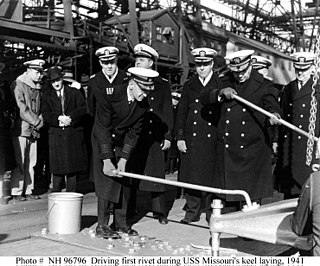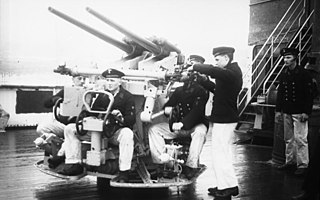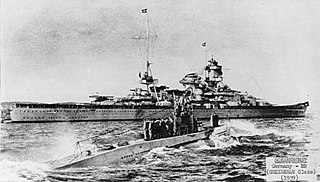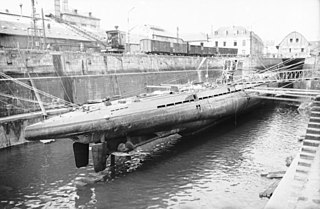Second patrol
U-65's second war patrol began on 8 June 1940. Over 30 days the boat crossed the North Sea, rounded the British Isles to the north and proceeded through the Celtic Sea to the Bay of Biscay. At 08:17 on 21 June, she encountered her first victim, the 1,177 ton Dutch steam merchant ship Berenice, outbound from Bordeaux, carrying 1,000 tons of manganese ore and 22 passengers. A single torpedo hit her amidships and she sank in three minutes. Out of 47 souls aboard, only nine survivors were pulled from the water by a coastal vessel. One of these men, the ship's master, died of his wounds before the remaining complement was landed at Falmouth in Cornwall. [4]

Bordeaux is a port city on the Garonne in the Gironde department in Southwestern France.

Falmouth is a town, civil parish and port on the River Fal on the south coast of Cornwall, England, United Kingdom. It has a total resident population of 21,797.
The following day, at 18:04, U-65 sank an unescorted tanker in the Bay of Biscay. This is believed to have been the 7,011 GRT French steam tanker Monique, although there were no survivors to confirm her identity. [5] The only trace ever found of Monique was the body of one of her sailors, which washed ashore near La Coruña, Spain. [6]
Near midday on 30 June, U-65 located and attacked convoy SL-36 and reported hits on two ships. In fact only one, the 5,802 GRT British steam merchantman Clan Ogilvy was hit. There were no casualties; the damaged ship was assisted by HMS Vesper and Gladiolus and arrived at Falmouth on 4 July. [7]
One day later (1 July), the U-Boat attacked convy OA-175. At 13:51 she fired her sole remaining torpedo at the Dutch steam merchant vessel Amstelland about 380 nmi (700 km; 440 mi) southwest of Lands End. The torpedo struck her on the starboard side; one crew member was blown overboard and drowned. Kptlt. Stockhausen claimed to have sunk his target, but despite being disabled Amstelland remained afloat for two days with a flooded Number 5 hold before being taken in tow by the rescue tug HMS Marauder. The Flower-classcorvette Calendula escorted the tug and her charge to Falmouth, where they arrived on 5 July. [8]
The last of her torpedoes expended, U-65 headed for home. This successful patrol was terminated at Wilhelmshaven on 7 July. [9]
Fourth patrol
U-65 stood out of Lorient on 21 August 1940 for her fourth patrol. After a stop of about six days at Brest, the North Atlantic patrol began in earnest. No targets were sighted until 20:00 on 14 September, when convoy HX 70 was located about 180 nmi (330 km; 210 mi) off Barra Head (in Scotland).
At 21:18, a torpedo was fired but missed ahead of the Norwegian MV Hird's bow. Reacting to the attack, the merchantman began zigzagging at full speed, trying to escape. Due to the evasive course, it took nine hours to reach a new firing position, but at 06:05 a single torpedo fired from U-65's stern tube struck the merchant vessel on the starboard side between the bridge and the foremast. As the ship developed a heavy list, the crew abandoned their vessel in one lifeboat and a gig, signalling a nearby trawler to pick them up. The Germans observed the crew being rescued and the Hird sinking at 20:30. The trawler, the Icelandic Þórólfur (English: Thorolf), landed the survivors at Fleetwood on England's west coast on 17 September. [10] [11]
A second successful attack occurred on 17 September 1940, when the boat torpedoed the British steam merchant ship Treganna which had been travelling with convoy HX 71. A single torpedo hit sent her to the bottom 78 nmi (144 km; 90 mi) northwest of Rockall in a matter of seconds; of her 37 crew, only four survived. They were picked up by the British merchantman Filleigh from the same convoy, and landed at Avonmouth. [12] [13]
Another twelve days at sea provided no additional targets; U-65 returned to Lorient on 25 September.
Fifth patrol
Several weeks later, on 15 October, U-65 sortied from Lorient, bound for the west coast of Africa and the South Atlantic. This would become both her longest and most successful patrol. A full month at sea passed before the submarine spotted her first target, the 5,168 GRT British steam merchant vessel Kohinur; recently separated from convoy OB 235. At 15:11, U-65 attacked and sank her about 250 nmi (460 km; 290 mi) north of the Equator. Initially, 68 of 85 men aboard survived, however many of them were killed a few hours later when U-65 sank her second victim of the patrol, the 7,614 GRT Norwegian motor tanker Havbør. [14]
British sailors on a raft from Kohinur had warned Havbør that a submarine was in the area, but boats were lowered to assist the 31 survivors anyhow. While this operation was in progress, Havbør was hit on the port side by a single torpedo from U-65 and immediately caught fire, burning oil spread over the surface of the water and engulfed many of the boats involved in the rescue operation. 28 members of Havbør's crew (including the ship's master) and all 31 men from Kohinur perished in the flames. The tanker sank seven hours later. Of the five survivors, one died of his wounds before rescue finally arrived on 24 November. The four remaining men were landed at Freetown in Sierra Leone. [15] [16]
On 16 November, the submarine found her next mark in the 3,059 GRT British steam merchant ship Fabian about 350 nmi (650 km; 400 mi) west of Freetown. A single torpedo at 14:29 hit her in the foreship. The U-Boat surfaced and finished off the stricken freighter with five hits out of eight rounds from the deck gun and she sank with the loss of six men. The 33 survivors were questioned by the Germans, who treated two injured men and provided food and water before departing the scene. [17]
At 18:02 on 18 November, U-65 sighted the unescorted British motor tanker Congonian. The first torpedo hit the tanker's engine compartment. A coup de grâce followed at 18:12, hitting her near the stern. One man was lost, the remaining 35 crew members were picked up by the British cruiser HMS Devonshire and landed at Freetown a few days later (29 November). [18]
U-65 became the first U-Boat to cross the Equator on 11 December 1940. [19]
After the sinking of Congonian, more than a month passed before U-65 encountered her next victim. At 16:05 on 21 December, the unescorted (neutral) Panamanian steam tanker Charles Pratt was hit amidships by a single torpedo. Although Stockhausen noted that the neutral flags painted on her sides were clearly visible, he decided to attack without warning as it was clear (based on her position and heading) that she was bound for an enemy port. The tanker's fire suppression system was damaged in the attack, the crew abandoned their vessel in two portside lifeboats. A second torpedo hit on the starboard side just forward of the midship house about 20 minutes later, showering the surrounding water with debris, some of which barely missed the lifeboats. Although this second attack extinguished the fire, the flooding was too much and the ship sank with a heavy list. The survivors were picked up a few days later by the British merchantmen Gascony and Langleegorse and landed at Freetown. [20]
On Christmas Eve U-65 encountered the steam tanker British Premier, a straggler from convoy SLS-60. Two torpedoes sealed her fate at 16:41 ; she was sunk about 200 nmi (370 km; 230 mi) southwest of Freetown. The ship's master, thirty crew and a gunner were lost in the sinking. Of the thirteen survivors, nine were picked up on 3 January 1941 by HMS Hawkins and landed at Freetown. The other four drifted in an open boat for 41 days (25 of those without food) before being rescued by HMS Faulknor. [21]
Three days later, the unescorted Norwegian steam merchant vessel Risanger (5,455 GRT) was sighted. At 11:31 a single torpedo fired from U-65's stern hit her amidships. U-65 surfaced and fired 70 rounds from the deck gun to finish off the merchant ship, which sank with her screw still turning. All 29 men aboard abandoned ship and were picked up a few days later by the Norwegian motor tanker Belinda. They were landed at Cape Town, South Africa on 10 January 1941. [22]
On 31 December, U-65 sighted the 8,532 GRT motor tanker British Zeal traveling on a non-evasive course at 10.5 knots east of the Cape Verde Islands. The submarine fired two torpedoes at 17:52, one of which became hot in the tube and had to be launched manually; both of these shots missed. At 23:00 a lookout spotted another torpedo track and the helm was thrown hard to starboard, but the torpedo struck the tanker squarely on the starboard side under the bridge, rupturing Number 2 tank. Despite rough seas, the crew took to the lifeboats immediately. A first coup de grâce missed, due to a malfunction, but a second struck the starboard side at the bulkhead between Numbers 3 and 4 tanks about 30 minutes after the first hit. The darkness and adverse weather prevented use of the deck gun, but having observed the crew abandoning ship the submarine departed the area, assuming the tanker would sink.
At first light, the tanker's crew spotted their still floating ship and re-boarded her. Despite three flooded tanks, two large holes in the starboard side, and a deck torn open by the explosions the engine room was found to be intact. The crew raised steam and tested the engines and steering, but then abandoned the ship again, fearing the submarine was still nearby. At dawn the next day, the crew re-boarded the vessel a second time, raised steam and headed toward Bathurst at five knots. A few hours later the British destroyer HMS Encounter arrived, offered assistance, and then left to search for the long-departed attacker. The damaged tanker continued alone until joined by the rescue tug HMS Hudson on 4 January. Despite heavy damage and inclement weather, British Zeal made harbour at Freetown on 8 January. She left the port after temporary repairs for more permanent restoration in Baltimore. The ship returned to service in February 1942. [23]
A final kill was added to the submarine's tally on 2 January 1941. At 22:07 a single torpedo from U-65 struck the British steam merchant ship Nalgora (6,579 GRT) about 350 nmi (650 km; 400 mi) north of the Cape Verde Islands. About 20 minutes later, the U-Boat surfaced and finished off the stricken vessel with the deck gun. All 105 souls aboard the merchantman survived. 86 were picked up by the British merchant ships Nolisement and Umgeni after eight days adrift. The remaining 19 reached land in the Cape Verde Islands. [24]
After months at sea, U-65 returned to the U-Boat pens at Lorient on 10 January 1941. In honor of this highly successful patrol, Stockhausen was promoted to Korvettenkapitän and awarded the Knight's Cross of the Iron Cross. He left the boat at this time and assumed command of the newly formed 26th U-boat Flotilla. [25]





















